ARISTON ATL83TX User Manual

Instructions for use
GB |
|
F |
|
|
|
|
|
English, 1 |
Français, 13 |
||
WASHING MACHINE
Contents
GB
Installation, 2-3
Unpacking and levelling, 2
Electric and water connections, 2-3 The first wash cycle, 3
Technical details, 3
CIS ES
РУССКИЙ, 25 |
Español, 37 |
IT
Italiano, 49
AVTL 83
Washing machine description, 4-5
Control panel, 4
How to open and shut the drum, 5 Leds, 5
Starting and Programmes, 6
Briefly: how to start a programme, 6 Programme table, 6
Personalisations, 7
Setting the temperature, 7
Setting the spin cycle, 7
Functions, 7
Detergents and laundry, 8
Detergent dispenser, 8
Bleach cycle, 8
Preparing your laundry, 8
Special items, 8
Woolmark Platinum Care, 8
Precautions and advice, 9
General safety, 9 Disposal, 9
Saving energy and respecting the environment, 9
Care and maintenance, 10
Cutting off the water or electricity supply, 10 Cleaning your appliance, 10
Caring for your appliance door and drum, 10 Cleaning the pump, 10
Checking the water inlet hose, 10 Cleaning the detergent dispenser, 10
Troubleshooting, 11
Service, 12
Before calling for Assistance, 12
1
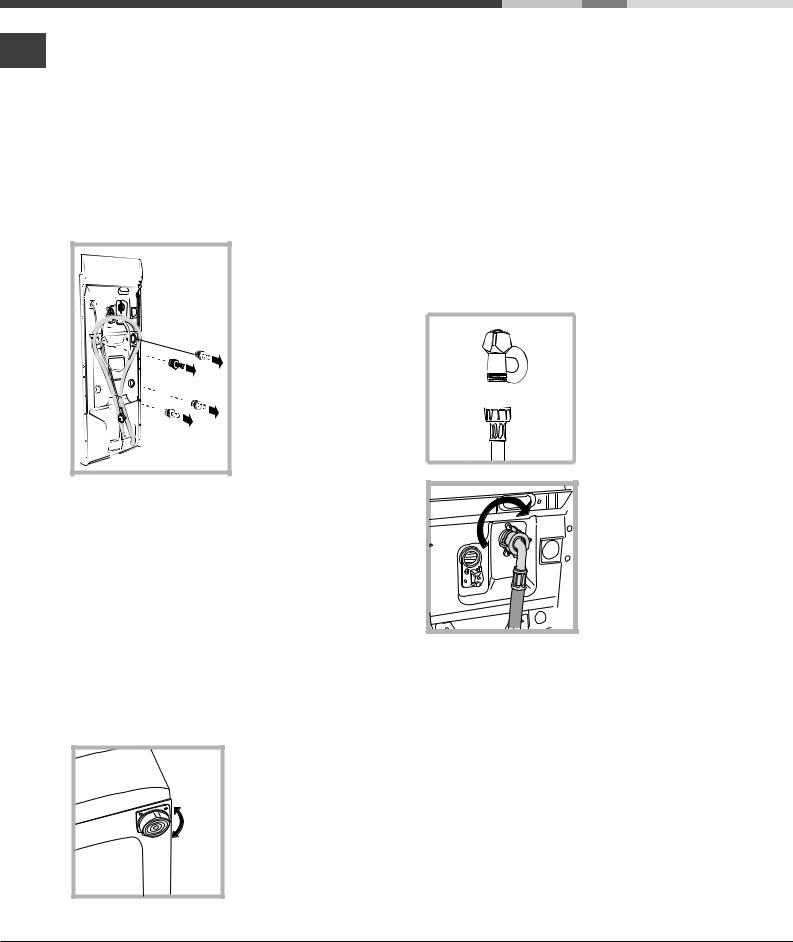
Installation
Keep this instruction manual in a safe place for GB future reference. Should the appliance be sold,
transferred or moved, make sure the instruction manual accompanies the washing machine to inform the new owner as to its operation and features.
Read these instructions carefully: they contain vital information on installation, use and safety.
Unpacking and levelling
Unpacking |
1.Unpack the washing machine.
2.Check whether the washing machine has been damaged during transport. If this is the case, do not install it and contact your retailer.
3.Remove the four protective screws and the rubber washer with the respective spacer, situated on the rear of the appliance (see figure).
4.Seal the gaps using the plastic plugs provided.
5.Keep all the parts: you will need them again if the washing machine needs to be moved to another location.
Warning: should the screws be re-used, make sure you fasten the shorter ones at the top.
Packaging materials are not children's toys.
Levelling
Your machine may make a considerable amount of noise if the two front feet have not been adjusted correctly.
1. Install the washing machine on a flat sturdy floor, without resting it up against walls,
furniture cabinets or other.
2. If the floor is not perfectly level, compensate for any unevenness by tightening or
loosening the adjustable front feet (see figure); the angle of inclination, measured according to the worktop, must not exceed 2°.
Levelling your appliance correctly will provide it with stability and avoid any vibrations, noise and shifting during operation. If it is placed on a fitted or loose carpet, adjust the feet in such a way as to allow enough room for ventilation beneath the washing machine.
Electric and water connections
Connecting the water inlet hose
1. Insert seal A into the end of the inlet hose and screw the latter onto a
cold water tap with a 3/4
gas threaded mouth (see

 A figure).
A figure).
Before making the connection, allow the water to run freely until it is perfectly clear.
2. Connect the other end of the water inlet hose to the washing machine, screwing it onto the appliance's cold water inlet, situated on the top right-hand side on the rear of the appliance
(see figure).
3. Make sure there are no kinks or bends in the hose.
The water pressure at the tap must be within the values indicated in the Technical details table
(on the next page).
If the water inlet hose is not long enough, contact a specialist store or an authorised serviceman.
2
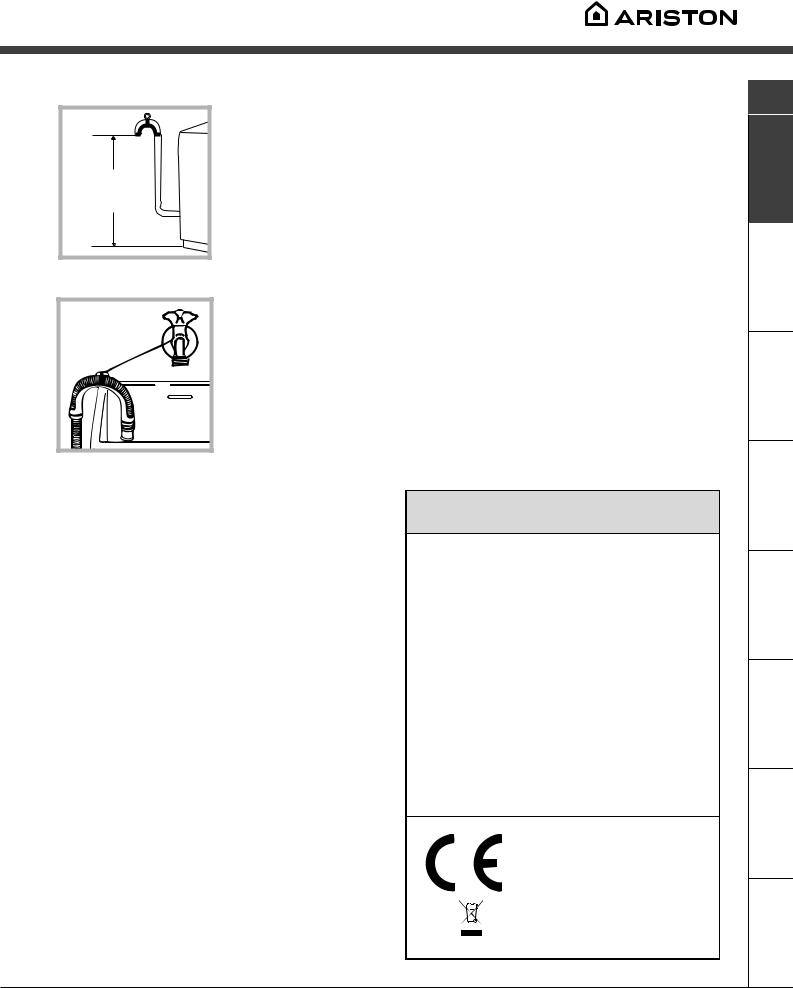
65 - 100 cm |
underwater. |
Connecting the drain hose
Connect the drain hose, without bending it, to a draining duct or a wall drain situated between 65 and 100 cm from the floor;
alternatively, place it over the edge of a basin, sink or tub, fastening the duct supplied to the tap (see figure). The free end of the hose should not be
outdoor environment, not even when the area is sheltered, because it may be very dangerous to leave it exposed to rain and thunderstorms.
When the washing machine is installed, the main socket must be within easy reach.
Do not use extensions or multiple sockets.
The power supply cable must never be bent or dangerously compressed.
The power supply cable must only be replaced by an authorised serviceman.
Warning! The company denies all liability if and when these norms are not respected.
The first wash cycle
Once the appliance has been installed, and before you use it for the first time, run a wash cycle with detergent and no laundry, setting the 90°C programme without a pre-wash cycle.
We advise against the use of hose extensions; in case of absolute need, the extension must have the same diameter as the original hose and must not exceed 150 cm in length.
Electric connection
Before plugging the appliance into the mains socket, make sure that:
•the socket is earthed and in compliance with the applicable law;
•the socket is able to sustain the appliance's maximum power load indicated in the Technical details table (on the right);
•the supply voltage is included within the values i ndicated on the Technical details table
(on the right);
•the socket is compatible with the washing machine's plug. If this is not the case, replace the socket or the plug.
The washing machine should not be installed in an
Technical details
Model |
AVTL 83 |
|
|
|
|
|
40 cm wide |
|
Dimensions |
85 cm high |
|
|
60 cm deep |
|
|
|
|
Capacity |
from 1 to 5 kg |
|
|
|
|
Electric |
voltage 220/230 Volts 50 Hz |
|
connections |
maximum absorbed power 1850 W |
|
|
|
|
Water |
maximum pressure 1 MPa (10 bar) |
|
minimum pressure 0.05 MPa (0.5 bar) |
||
connections |
||
drum capacity 42 litres |
||
|
||
|
|
|
Spin speed |
up to 800 rpm |
|
|
|
|
Control |
|
|
programmes |
programme 3; temperature 60°C; |
|
according to |
run with a load of 5 kg. |
|
IEC456 directive |
|
This appliance is compliant with the following European Community Directives:
-73/23/CEE of 19/02/73 (Low Voltage) and subsequent amendments
-89/336/CEE of 03/05/89 (Electromagnetic Compatibility) and subsequent amendments
-2002/96/CE
GB
Precautions Detergents Programmes Description Installation
Service Troubleshooting Care
3

Washing machine description
Control panel
GB
SPIN SPEED |
TEMPERATURE |
knob |
knob |
ON/OFF key
LID LOCKED
LED
LEDs START/RESET
key
FUNCTION |
PROGRAMME |
keys |
knob |
Detergent dispenser to add detergent and fabric softener (see page 8).
LEDs to find out which wash cycle phase is under way. If the Delay Timer function has been set, the time left until the programme starts will be indicated (see page 5).
SPIN SPEED knob to set the spin speed or exclude the spin cycle completely (see page 7).
FUNCTION keys to select the functions available. The button corresponding to the function selected will remain on.
TEMPERATURE knob to set the temperature or the cold wash cycle (see page 7).
ON/OFF key to turn the washing machine on and off.
START/RESET key to start the programmes or cancel incorrect settings.
ON-OFF/LID LOCK led ,to find out whether the washing machine is on (flashing) and if the lid may be opened (see page 5).
PROGRAMME knob to set the programmes (see page 6).
The knob stays still during the cycle.
 ON-OFF/LID LOCK led:
ON-OFF/LID LOCK led:
If this LED is on, the appliance Lid is locked to prevent it from being opened accidentally; to avoid any damages, you must wait for the lamp to flash before you open the Lid.
.
The rapid flashing of the ON-OFF/LID LOCK Led together with the flashing of at least one other LED indicates there is an abnormality. Call for Technical Assistance.
4
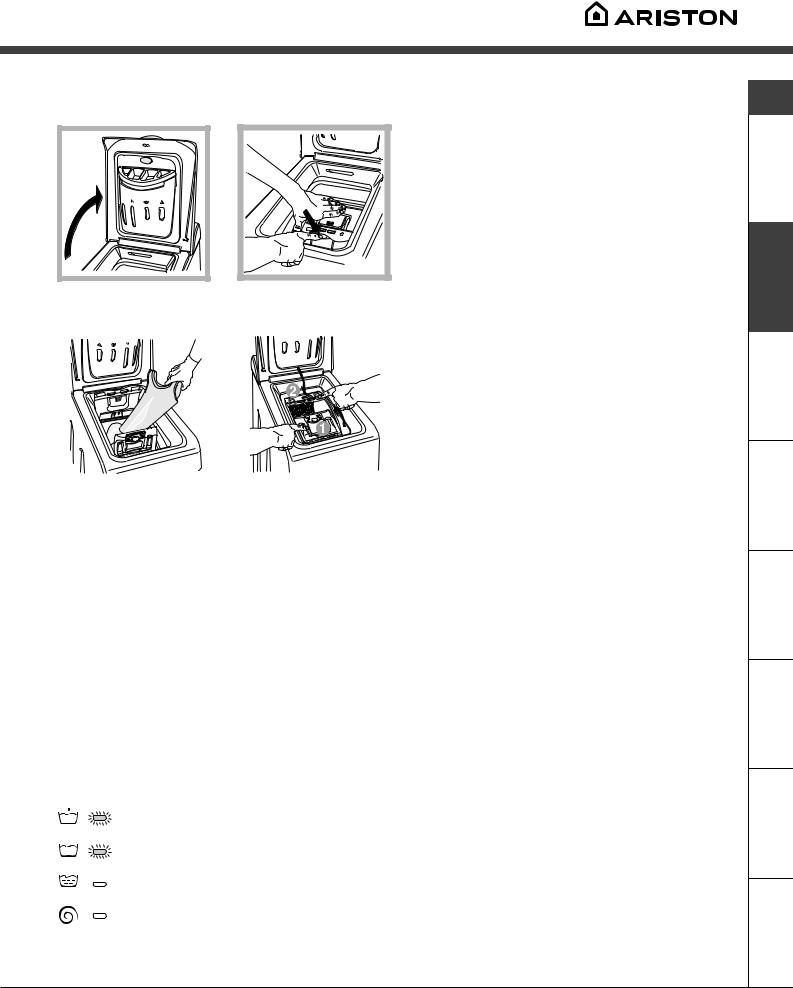
How to open and to close the drum
Fig. 1 |
Fig. 2 |
|||||
|
|
|
|
|
|
|
|
|
|
|
|
|
|
|
|
|
|
|
|
|
|
|
|
|
|
|
|
Fig. 3 |
Fig. 4 |
Leds
The LEDS provide important information.
This is what they can tell you:
Cycle phase under way:
During the wash cycle, the LEDs gradually illuminate on to indicate the cycle phase under way:
Prewash
Wash
Rinse
Spin cycle
Note: during draining, the LED corresponding to the Spin cycle phase will be turned on.
A) Opening (Fig. 1).
Lift the external lid and open it completely.
B)Then open the drum using both hands as shown in Fig. 2:
-press the button indicated by the arrow in Fig. 2 lightly downwards, with one hand firmly resting on
the doors to prevent them from suddenly opening and hurting your fingers;
-therefore follow the appliance doors along as these unhook and open easily.
C)Loading the washing machine. (Fig. 3).
D)Shutting (Fig. 4).
-close the drum fully by first shutting the front door followed by the rear one;
-then ensure the hooks on the front door are perfectly housed within the seat of the rear door;
-after the hooks have clicked into position, press both doors lightly downwards to make sure they do not come loose;
-finally shut the external lid.
Function keys
The FUNCTION KEYS also act like LEDS.
When a function is selected, the corresponding button is illuminated.
If the function selected is incompatible with the programme set, the button will flash and the function will not be enabled.
If you set a function that is incompatible with another function you selected previously, only the last one selected will be enabled.
GB
Precautions Detergents Programmes Description Installation
Service Troubleshooting Care
5

Starting and Programmes
Briefly: starting a programme
GB
1. |
Switch the washing machine on by pressing button . |
|
All the LEDS will light up for a few seconds and |
|
the ON-OFF/DOOR LOCK Led will begin to flash. |
2. |
Load your laundry into the washing machine, add |
|
the detergent and any fabric softener (see page 8) |
|
and shut the appliance door. |
3. |
Set the PROGRAMME knob to the programme |
|
required. |
4. |
Set the wash temperature (see page 7). |
5.Set the spin speed (see page 7).
6.Start he programme by pressing the START/RESET button.
To cancel it, keep the START/RESET button pressed for at least 2 seconds.
7.When the programme is finished, the ON-OFF/ DOOR LOCK Led will flash to indicate that the appliance door can be opened. Take out your laundry and leave the appliance door ajar to allow
the drum to dry thoroughly. Turn the washing machine off by pressing button  .
.
Programme table
Type of fabric and degree |
Program- |
Wash |
Detergent |
Fabric |
Bleaching |
Cycle |
|
||
temper- |
|
|
/option |
length |
Description of wash cycle |
||||
of soil |
mes |
|
|
softener |
|||||
at. |
Pre- |
Wash |
Bleach |
(minutes) |
|
||||
|
|
|
|
|
|||||
|
|
|
|
wash |
|
|
|
|
|
Cotton |
|
|
|
|
|
|
|
|
|
Extremely soiled whites |
|
|
|
|
|
|
|
|
Pre-wash, wash cycle, rinse |
1 |
90°C |
• |
• |
• |
|
137 |
cycles, intermediate and final |
||
(sheets, tablecloths, etc.) |
|
||||||||
|
|
|
|
|
|
|
|
spin cycles |
|
|
|
|
|
|
|
|
|
|
|
Extremely soiled whites |
|
|
|
|
|
|
Delicate/ |
|
Wash cycle, rinse cycles, |
2 |
90°C |
|
• |
• |
129 |
intermediate and final spin |
|||
(sheets, tablecloths, etc.) |
|
Traditional |
|||||||
|
|
|
|
|
|
|
cycles |
||
|
|
|
|
|
|
|
|
|
|
Heavily soiled whites and |
|
|
|
|
|
|
Delicate/ |
|
Wash cycle, rinse cycles, |
3 |
60°C |
|
• |
• |
144 |
intermediate and final spin |
|||
fast colours |
|
Traditional |
|||||||
|
|
|
|
|
|
|
cycles |
||
|
|
|
|
|
|
|
|
|
|
Heavily soiled whites and |
|
|
|
|
|
|
Delicate/ |
|
Wash cycle, rinse cycles, |
4 |
40°C |
|
• |
• |
78 |
intermediate and final spin |
|||
fast colours |
|
Traditional |
|||||||
|
|
|
|
|
|
|
cycles |
||
|
|
|
|
|
|
|
|
|
|
Slightly soiled whites and |
|
|
|
|
|
|
Delicate/ |
|
Wash cycle, rinse cycles, |
delicate colours (shirts, |
5 |
30°C |
|
• |
• |
70 |
intermediate and final spin |
||
|
Traditional |
||||||||
jumpers, etc.) |
|
|
|
|
|
|
|
cycles |
|
|
|
|
|
|
|
|
|
||
Synthetics |
|
|
|
|
|
|
|
|
|
Heavily soiled fast colours |
6 |
60°C |
|
• |
• |
Delicate |
79 |
Wash cycle, rinse cycles, anti- |
|
(baby linen, etc.) |
|
crease or delicate spin cycle |
|||||||
|
|
|
|
|
|
|
|
||
|
|
|
|
|
|
|
|
|
|
Heavily soiled fast colours |
7 |
50°C |
|
• |
• |
Delicate |
75 |
Wash cycle, rinse cycles, anti- |
|
(baby linen, etc.) |
|
crease or delicate spin cycle |
|||||||
|
|
|
|
|
|
|
|
||
Delicate colours (all types |
|
|
|
|
|
|
|
|
Wash cycle, rinse cycles, anti- |
of slightly soiled |
8 |
40°C |
|
• |
• |
Delicate |
65 |
||
|
crease or delicate spin cycle |
||||||||
garments) |
|
|
|
|
|
|
|
|
|
|
|
|
|
|
|
|
|
|
|
Delicate colours (all types |
|
|
|
|
|
|
|
|
Wash cycle, rinse cycles and |
of slightly soiled |
9 |
30°C |
|
• |
• |
|
32 |
||
|
|
delicate spin cycl |
|||||||
garments) |
|
|
|
|
|
|
|
|
|
|
|
|
|
|
|
|
|
|
|
Delicate |
|
|
|
|
|
|
|
|
|
Wool |
10 |
40°C |
|
• |
• |
Delicate |
45 |
Wash cycle, rinse cycles and |
|
|
delicate spin cycle |
||||||||
|
|
|
|
|
|
|
|
|
|
|
|
|
|
|
|
|
|
|
|
Very delicate fabrics |
|
|
|
|
|
|
|
|
Wash cycle, rinse cycles, anti- |
(curtains, silk, viscose, |
11 |
30°C |
|
• |
• |
|
52 |
||
|
|
crease or draining cycle |
|||||||
etc.) |
|
|
|
|
|
|
|
|
|
|
|
|
|
|
|
|
|
|
|
PARTIAL PROGRAMMES |
|
|
|
|
|
|
|
|
|
Rinse |
|
|
|
|
|
• |
|
|
Rinse cycles and spin cycle |
|
|
|
|
|
|
|
|
|
|
Delicate rinse cycle |
|
|
|
|
|
• |
|
|
Rinse cycles, anti-crease or |
|
|
|
|
|
|
|
draining |
||
|
|
|
|
|
|
|
|
|
|
Spin cycle |
|
|
|
|
|
|
|
|
Draining and heavy duty spin |
|
|
|
|
|
|
|
|
cycle |
|
|
|
|
|
|
|
|
|
|
|
Delicate spin cycle |
|
|
|
|
|
|
|
|
Draining and delicate spin |
|
|
|
|
|
|
|
|
cycle |
|
|
|
|
|
|
|
|
|
|
|
Draining |
|
|
|
|
|
|
|
|
Draining |
|
|
|
|
|
|
|
|
||
|
|
|
|
|
|
|
|
|
|
Notes
For the anti-crease function: see Easy iron, opposite page. The information contained in the table is purely indicative.
Special programme
Daily 30' (programme 9 for Synthetics) is designed to wash lightly soiled garments in a short amount of time: it only lasts 30 minutes and allows you to save on both time and energy. By setting this programme (9 at 30°C), you can wash different fabrics together (except for woollen and silk items), with a maximum load of 3 kg.
We recommend the use of liquid detergent.
6

Personalisations
 Setting the temperature
Setting the temperature
Turn the TEMPERATURE knob to set the wash temperature (see Programme table on page 6). The temperature can be lowered, or even set to a cold wash ( ).
).
 Setting the spin speed
Setting the spin speed
Turn the SPIN SPEED knob to set the spin speed for the programme selected.
The maximum spin speeds for each programme are as follows:
Programmes |
Maximum spin speed |
Cottone |
800 rpm |
Synthetics |
800 rpm |
Wool |
600 rpm |
Silk |
no |
The spin speed can be lowered, or the spin cycle can be excluded altogether by selecting symbol  .
.
The washing machine will automatically prevent you from selecting a spin speed higher than the maximum speed for each programme.
Functions
To enable a function:
1.press the button corresponding to the desired function, according to the table below;
2.the function is enabled when the corresponding button is illuminated.
Note: The rapid flashing of the button indicates that the corresponding function cannot be selected for the programme set.
Function |
Effect |
Comments |
|
|
|
Enabled with |
|
|
|
|
|
|
programmes: |
|
|
|
|
|
||
Super |
Allows for an |
This function is incompatible with the RAPID function. |
1, 2, 3, 4, |
|||
Wash |
impeccable |
|
|
|
|
5, 6, 7, 8 |
|
wash, visibly |
|
|
|
|
|
|
whiter than a |
|
|
|
|
|
|
standard |
|
|
|
|
|
|
Class A wash. |
|
|
|
|
|
|
|
|
|
|
||
Easy iron |
This option |
When this function is set, programmes 6, 7, 8, 11 and |
All |
|||
|
reduces the |
Delicate rinse will end with the laundry left to soak |
programmes |
|||
|
amount of |
(Anti-crease) and the Rinse cycle phase LED |
will |
except for |
||
|
creasing on |
flash. |
|
|
|
1, 2, 9, 10 |
|
fabrics, |
- to conclude the cycle, press the START/RESET |
|
and |
||
|
making them |
button; |
|
|
|
Draining. |
|
easier to iron. |
- to run the draining cycle alone, set the knob to the |
|
|||
|
|
relative symbol |
|
and press the START/RESET |
|
|
|
|
|
|
|||
|
|
button. |
|
|
|
|
|
|
|
|
|
||
Rapid |
Cuts the |
This function is incompatible with the SUPER WASH |
1, 2, 3, 4, |
|||
|
duration of |
function. |
|
|
|
5, 6, 7, 8 |
|
the wash |
|
|
|
|
Rinses |
|
cycle by 30%. |
|
|
|
|
|
|
|
|
|
|
||
Extra |
I ncreases the |
Recommended when the appliance has a full load or |
1, 2, 3, 4, 5, |
|||
Rinse |
efficiency of |
with large quantities of detergent. |
|
6, 7, 8, and |
||
|
the rinse. |
|
|
|
|
Rinse |
|
|
|
|
|
|
cycles. |
|
|
|
|
|
|
|
GB
Precautions Detergents Programmes Description Installation
Service Troubleshooting Care
7

Detergents and laundry
Detergent dispenser
GB
Good washing results also depend on the correct dose of detergent: adding too much detergent won't necessarily make for a more efficient wash, and may
in fact cause build up on the interior of your
appliance and even pollute the environment.
Open up the detergent dispenser and pour in the detergent and fabric softener, as follows.
compartment 1: Detergent for pre-wash
compartment 2: Detergent for the wash cycle (powder or liquid)
It is recommended that you place liquid detergent directly into the compartment using the appropriate dosing cup.
compartment 3: Additives (softener, etc.)
When pouring the softener in compartment 3, avoid exceeding the "max" level indicated.
The softener is added automatically into the machine during the last wash. At the end of the wash programme, some water will be left in compartment 3. This is used for the inlet of denser fabric softeners into the machine, i.e. to dilute the more concentrated softeners. Should more than a normal amount of water remain in compartment 3, this means the emptying device is blocked. For cleaning instructions, see page 10.
compartment 4: Bleach
Do not use hand wash detergent because it may form too much foam.
Bleach cycle
Traditional bleach should be used on sturdy white fabrics, and delicate bleach for coloured fabrics, synthetics and for wool.
When pouring in the bleach, be careful not to exceed the "max" level indicated on compartment 4 ..
To run the bleach cycle alone, pour the bleach into compartment 4 and set the Extra Rinse option  .
.
.
Preparing your laundry
•Divide your laundry according to:
-the type of fabric/the symbol on the label.
-the colours: separate coloured garments from whites.
•Empty all pockets and check for loose buttons.
•Do not exceed the weight limits stated below, which refer to the weight when dry:
Sturdy fabrics: max 5 kg Synthetic fabrics: max 2.5 kg Delicate fabrics: max 2 kg Wool: max 1 kg
How much does your laundry weigh?
1sheet 400-500 g
1pillow case 150-200 g
1tablecloth 400-500 g
1bathrobe 900-1,200 g
1towel 150-250 g
Special items
Curtains: fold curtains and place them in a pillow case or mesh bag. Wash them separately without exceeding half the appliance load. Use programme 11 which excludes the spin cycle automatically.
Quilted coats and windbreakers: if they are padded with goose or duck down, they can be machine-washed. Turn the garments inside out and load a maximum of 2-3 kg, repeating the rinse cycle once or twice and using the delicate spin cycle. Trainers: remove any mud. They can be washed together with jeans and other tough garments, but not with whites.
Wool: for best results, use a specific detergent, taking care not to exceed a load of 1 kg.
Woolmark Platinum Care
As gentle as a hand wash.
Ariston sets a new standard of superior performance that has been endorsed by


 The Woolmark Company with the prestigious Woolmark Platinum Care brand. Look for the Woolmark Platinum Care logo on the washing machine to ensure you can safely and effectively wash wool garments labelled as "hand wash" (M.0303):
The Woolmark Company with the prestigious Woolmark Platinum Care brand. Look for the Woolmark Platinum Care logo on the washing machine to ensure you can safely and effectively wash wool garments labelled as "hand wash" (M.0303):
Set programme 10 for all "Hand wash" garments, using the appropriate detergent.
(max load 1 kg.)
8

Precautions and advice
The washing machine was designed and built in compliance with the applicable international safety regulations. The following information is provided for your safety and should consequently be read carefully.
General safety
•This appliance has been designed for nonprofessional, household use and its functions must not be changed.
•This washing machine should only be used by adults and in accordance with the instructions provided in this manual.
•Never touch the washing machine when barefoot or with wet or damp hands or feet.
•Do not pull on the power supply cable to unplug the appliance from the electricity socket. Pull the plug out yourself.
•Do not open the detergent dispenser while the appliance is in operation.
•Do not touch the drain water as it could reach very high temperatures.
•Never force the washing machine door: this could damage the safety lock mechanism designed to prevent any accidental openings.
•In the event of a malfunction, do not under any circumstances touch internal parts in order to attempt repairs.
•Always keep children well away from the appliance while in operation.
•The appliance door tends to get quite hot during the wash cycle.
•Should it have to be moved, proceed with the help of two or three people and handle it with the utmost care. Never try to do this alone, because the appliance is very heavy.
•Before loading your laundry into the washing machine, make sure the drum is empty.
Disposal
• Disposal of old electrical appliances
The European Directive 2002/96/EC on Waste Electrical and Electronic Equipment (WEEE), requires that old household electrical appliances must not be disposed of in the normal unsorted municipal waste stream. Old appliances must be collected separately in order to optimise the recovery and recycling of the materials they contain and reduce the impact on
human health and the environment.
The crossed out "wheeled bin" symbol on the product reminds you of your obligation, that when you dispose of the appliance it must be separately collected.
Consumers should contact their local authority or retailer for information concerning the correct disposal of their old appliance.
•Disposing of an old washing machine:
before scrapping your appliance, cut the power supply cable and remove the appliance door.
Saving energy and respecting the environment
Environmentally-friendly technology
If you only see a little water through your appliance door, this is because thanks to the latest technology, your washing machine only needs less than half the amount of water to get the best results: an objective reached to respect the environment.
Saving on detergent, water, energy and time
•To avoid wasting resources, the washing machine should be used with a full load. A full load instead of two half loads allows you to save up to 50% on energy.
•The pre-wash cycle is only necessary on extremely soiled garments. Avoiding it will save on detergent, time, water and between 5 and 15% energy.
•Treating stains with a stain remover or leaving them to soak before washing will cut down the need to wash them at high temperatures. A programme at 60°C instead of 90°C or one at 40°C instead of 60°C will save up to 50% on energy.
•Use the correct quantity of detergent depending on the water hardness, how soiled the garments are and the amount of laundry you have, to avoid wastage and to protect the environment: despite being biodegradable, detergents do contain ingredients that alter the natural balance of the environment. In addition, avoid using fabric softener as much as possible.
•If you use your washing machine from late in the afternoon until the early hours of the morning, you will help reduce the electricity board's peak load.
•If your laundry has to be dried in a tumble dryer, select a high spin speed. Having the least water possible in your laundry will save you time and energy in the drying process.
GB
Precautions Detergents Programmes Description Installation
Service Troubleshooting Care
9

Care and maintenance
GB |
Cutting off the water or electricity |
|
supply |
|
|
|
• Turn off the water tap after every wash. This will |
|
limit the wear of your appliance's water system |
|
and also prevent leaks. |
|
• Unplug your appliance when cleaning it and |
|
during all maintenance operations. |
Cleaning your appliance
The exterior and rubber parts of your appliance can be cleaned with a soft cloth soaked in lukewarm soapy water. Do not use solvents or abrasives.
Cleaning the detergent dispenser
Remove the dispenser by raising it and pulling it out
(see figure).
Wash it under running water; this operation should be repeated
frequently.
Caring for your appliance door and drum
•Always leave the appliance door ajar to prevent unpleasant odours from forming.
Cleaning the pump
The washing machine is fitted with a self-cleaning pump that does not require any maintenance. Sometimes, small items (such as coins or buttons) may fall into the pre-chamber that protects the pump, situated in the lower part of the same.
Make sure the wash cycle has ended and unplug the appliance.
To recover any objects that have fallen into the prechamber:
1. remove the plinth at the bottom on the front side of the washing machine by pulling from the side with your hands (see diagram); (see figure); 2. unscrew the lid rotating it anticlockwise (see figure): a little water may trickle out. This is perfectly normal;
3. clean the interior thoroughly;
4. screw the lid back on;
5. reposition the panel, making sure the hooks are securely in place before you push it onto the appliance.
Checking the water inlet hose
Check the water inlet hose at least once a year. If you see any cracks, replace it immediately: during the wash cycles, water pressure is very strong and a cracked hose could easily split open.
Never use hoses that have already been used.
Disassembly:
Press lightly on the large button on the front of the detergent dispenser and pull it upwards (fig. 1).
How to clean the detergent dispenser
Cleaning:
Then clean the dispenser under a tap (fig. 3) using an old toothbrush and, once the pair of siphons inserted in the top of compartments 1 and 2 (fig. 4) have been pulled out, check whether the same are not clogged and then rinse them.
Reassembly:
Do not forget to reinsert the pair of siphons into the special housings and then to replace the dispenser into its seat, clicking it into place (fig. 4, 2 and 1).
Fig. 1 |
Fig. 2 |
Fig. 3 |
Fig. 4 |
|
|
|
|
10

Troubleshooting
Your washing machine could fail to work. Before calling for Assistance (see page 12), make sure the problem can't easily be solved by consulting the following list.
Problem
The washing machine won't start.
The wash cycle won't start.
Possible causes/Solution:
•The appliance is not plugged into the socket, or not enough to make contact.
•There has been a power failure.
•The appliance Lid is not shut properly. The Lid locked Led flashes.
•The  button has not been pressed.
button has not been pressed.
•The START/RESET button has not been pressed.
•The water tap is not turned on.
The washing machine fails to load water.
The washing machine continuously loads and unloads water.
The washing machine does not drain or spin.
The washing machine vibrates too much during the spin cycle.
The washing machine leaks.
The ON-OFF/DOOR LOCK Led flashes rapidly at the same time as at least one other LED.
There is too much foam.
•The water inlet hose is not connected to the tap.
•The hose is bent.
•The water tap is not turned on.
•There is a water shortage.
•The water pressure is insufficient.
•The START/RESET button has not been pressed.
•The drain hose is not fitted between 65 and 100 cm from the floor
(see page 3).
•The free end of the hose is underwater (see page 3).
•The wall drainage system doesn't have a breather pipe.
If the problem persists even after these checks, turn off the water tap, switch the appliance off and call for Assistance. If the dwelling is on one of the upper floors of a building, there may be drain trap problems causing the washing machine to load and unload water continuously. In order to avoid such an inconvenience, special anti-drain trap valves are available in shops.
•The programme does not foresee the draining: some programmes require enabling the draining manually (see page 6).
•The Easy iron option is enabled: to complete the programme, press the START/RESET button (see page 7).
•The drain hose is bent (see page 3).
•The drain duct is clogged.
•When the machine is installed, the locking screws for the oscillating assembly are still in place. Remove the screws (see page 2).
•The washing machine is not level (see page 2).
•The washing machine is closed in between furniture cabinets and the wall (see page 2).
•The water inlet hose is not screwed on correctly (see page 2).
•The detergent dispenser is obstructed (to clean it, see page 10).
•The drain hose is not secured properly (see page 3).
•Call for Assistance because this means there is an abnormality.
•The detergent is not suitable for machine washing (it should bear the definition "for washing machines" or "hand and machine wash", or the like).
GB
Precautions Detergents Programmes Description Installation
Service Troubleshooting Care
11

Service
GB
Service
Before calling for Assistance:
• Check whether you can solve the problem on your own (see page 11);
•Restart the programme to check whether the problem has been solved;
•If this is not the case, contact an authorised Technical Service Centre on the telephone number provided on the guarantee certificate.
If the machine has been installed or used incorrectly, you may be charged for the maintenance callout service.
Always request the assistance of authorised servicemen.
Notify the operator of:
•the type of problem;
•the appliance model (Mod.);
•the serial number (S/N);
This information can be found on the data plate situated on the rear of the washing machine.
12

Mode d'emploi
F
Français
AVTL 83
LAVE-LINGE TOP LOADER
Sommaire
F
Installation, 14-15
Déballage et mise à niveau, 14
Raccordements hydrauliques et électriques, 14-15
Premier cycle de lavage, 15
Caractéristiques techniques, 15
Description du lave-linge, 16-17
Bandeau de commandes, 16
Comment ouvrir et fermer le tambour, 17
Ecran, 17
Mise en marche et Programmes, 18
En bref: démarrage d'un programme, 18
Tableau des programmes, 18
Personnalisations, 19
Réglage de la température, 19
Réglage de l'essorage, 19
Options, 19
Produits lessiviels et linge, 20
Tiroir à produits lessiviels, 20
Cycle blanchissage, 20
Triage du linge, 20
Pièces de linge particulières, 20
Woolmark Platinum Care, 20
Précautions et conseils, 21
Sécurité générale, 21
Mise au rebut, 21
Economies et respect de l'environnement, 21
Entretien et soin, 22
Coupure de l'arrivée d'eau et de courant, 22
Nettoyage du lave-linge, 22
Entretien du couvercle et du tambour, 22
Nettoyage de la pompe, 22
Nettoyage du tiroir à produits lessiviels, 22
Contrôle du tuyau d'arrivée de l'eau, 22
Anomalies et remèdes, 23
Assistance, 24
Avant d'appeler le service après-vente, 24
13

Installation
Conservez ce mode d'emploi pour pouvoir le consulter à
Ftout moment. En cas de vente, de cession ou de déménagement, veillez à ce qu'il suive toujours le lave-linge pour que son nouveau propriétaire soit informé sur son mode de fonctionnement et puisse profiter des conseils correspondants.
Lisez attentivement les instructions: elles fournissent d'importantes informations sur l'installation, l'utilisation et la sécurité.
Déballage et mise à niveau
Déballage: enlever les 4 vis
1. Déballez le lave-linge.
2. Contrôlez que le lave-linge n'a pas été endommagé pendant le transport. S'il est abîmé, ne le raccordez pas et contactez votre revendeur.
3. Enlevez les quatre vis de protection pour le transport, le caoutchouc et la cale, placés dans la partie arrière
(voir figure).
4.Bouchez les trous à l'aide des bouchons plastique fournis.
5.Conservez bien toutes ces pièces: il faudra les remonter en cas de transport du lave-linge.
Attention: en cas de réutilisation, les vis plus courtes doivent être montées dessus.
Les emballages ne sont pas des jouets pour enfants.
Mise à niveau
Votre appareil peut s’avérer bruyant si vous n’avez pas bien réglé ses deux pieds avant.
1. Installez le lave-linge sur un sol plat et rigide, sans l'appuyer contre des murs, des meubles ou autre.
2. Si le sol n'est pas parfaitement horizontal, vissez ou dévissez les petits pieds avant (voir figure) pour niveler l'appareil; son angle d'incli-
naison, mesuré sur le plan de travail, ne doit pas dépasser 2°.
Une bonne mise à niveau garantit la stabilité de la machine et évite qu'il y ait des vibrations, du bruit et des déplacements en cours de fonctionnement. Si la machine est posée sur de la moquette ou un tapis, réglez les petits pieds de manière à ce qu'il y ait suffisamment d'espace pour assurer une bonne ventilation.
Raccordements hydrauliques et électriques
Raccordement du tuyau d'arrivée de l'eau
1. Montez le joint A sur
l'extrémité du tuyau d'alimen-
tation et vissez-le à un robinet
d'eau froide à embout fileté 3/
4 gaz (voir figure).

 A
A
Faites couler l'eau jusqu'à ce qu'elle soit limpide et sans impuretés avant de raccorder.
2. Raccordez le tuyau d'alimentation au lave-linge en le vissant à la prise d'eau prévue, dans la partie arrière en haut à droite (voir figure).
3. Faites attention à ce que le tuyau ne soit ni plié ni écrasé.
La pression de l'eau doit être comprise entre les valeurs indiquées dans le tableau des Caractéristiques techniques
(voir page ci-contre).
Si la longueur du tuyau d'alimentation ne suffit pas, adressez-vous à un magasin spécialisé ou à un technicien agréé.
14
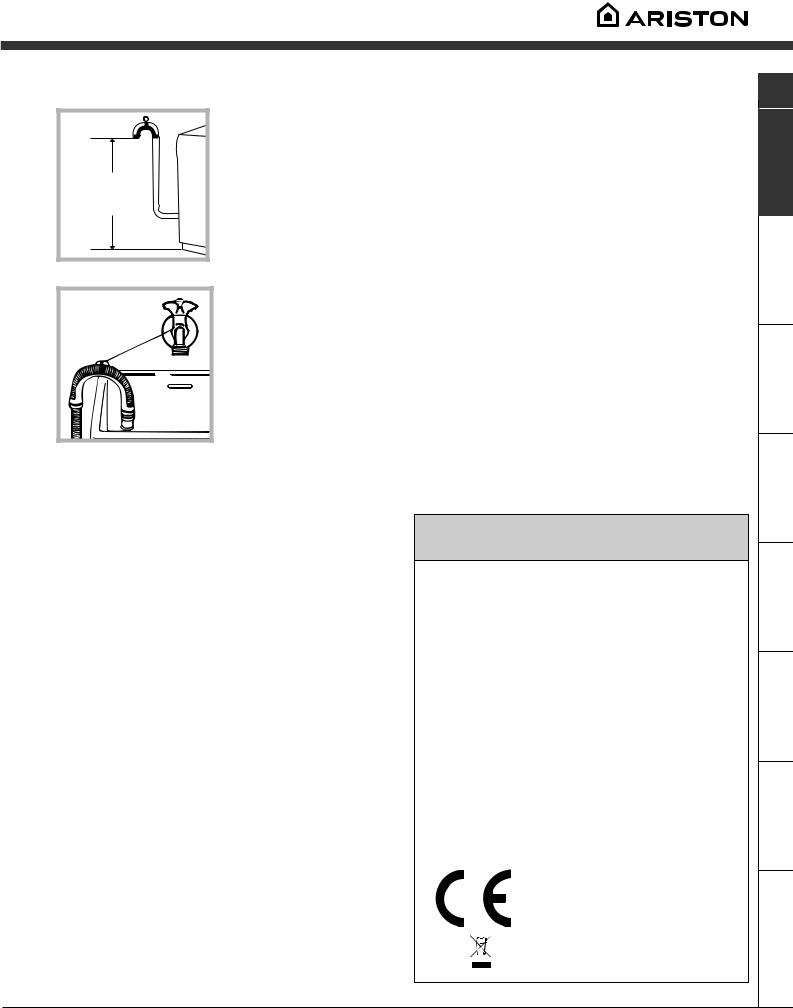
Raccordement du tuyau de vidange
65 - 100 cm |
Raccordez le tuyau d'évacuation, sans le plier, à un conduit d'évacuation ou à une évacuation murale placés à une distance du sol comprise entre 65 et 100 cm;
ou bien accrochez-le à un évier ou à une baignoire, dans ce cas, fixez le support en plastique fourni avec l'appareil au robinet (voir figure). L'extrémité libre du tuyau d'évacuation ne doit pas être plongée dans l'eau.
L'utilisation de tuyaux de rallonge est absolument déconseillée, si vous ne pouvez vraiment pas faire autrement vous devrez utiliser un tuyau de même diamètre et de longueur maximum de 150 cm.
Branchement électrique
Avant de brancher la fiche dans la prise de courant, contrôlez que:
•la prise dispose de mise à la terre et est conforme aux normes;
•la prise est bien apte à supporter la puissance maximale de la machine indiquée dans le tableau des Carcatéristiques techniques (voir ci-contre);
•la tension d'alimentation est bien comprise entre les valeurs figurant dans le tableau des Caractéristiques techniques (voir ci-contre);
•la prise est bien compatible avec la fiche du lave-linge. Autrement, remplacez la prise ou la fiche.
Votre lave-linge ne doit pas être installé dehors, même à l'abri, car il est très dangereux de le laisser exposé à la pluie et aux orages.
Après installation du lave-linge, la prise de courant doit être facilement accessible.
N'utilisez ni rallonges ni prises multiples.
Le câble ne doit être ni plié ni écrasé.
Le câble d'alimentation ne doit être remplacé que par des techniciens agréés.
Attention! Nous déclinons toute responsabilité en cas de non respect des normes énumérées ci-dessus.
Premier cycle de lavage
Avant la première utilisation de la machine, effectuez un cycle de lavage avec un produit lessiviel mais sans linge et sélectionnez le programme à 90°C sans prélavage.
Caractéristiques techniques
Modèle |
AVTL 83 |
|
|
|
|
|
largeur 40 cm |
|
Dimensions |
hauteur 85 cm |
|
|
profondeur 60 cm |
|
|
|
|
Capacité |
de 1 à 5 kg |
|
|
|
|
Raccordements |
tension 220/230 Volt 50 Hz |
|
électriques |
puissance maximale absorbée 1850 W |
|
|
|
|
Raccordements |
pression maximale 1 MPa (10 bar) |
|
pression minimale 0,05 MPa (0,5 bar) |
||
hydrauliques |
||
capacité du tambour 42 litres |
||
|
||
|
|
|
Vitesse |
jusqu'à 800 tours minute |
|
d'essorage |
||
|
||
|
|
|
Programmes de |
programme 3; température 60°C; |
|
contrôle selon la |
||
effectué avec une charge de 5 kg. |
||
norme IEC456 |
||
|
||
|
|
|
|
Cet appareil est conforme aux |
|
|
Directives Communautaires suivantes: |
|
|
- 73/23/CEE du 19/02/73 (Basse |
|
|
Tension) et modifications suivantes |
|
|
- 89/336/CEE du 03/05/89 |
|
|
(Compatibilité électromagnétique) et |
|
|
modifications suivantes |
|
|
- 2002/96/CE |
F
Installation
Description
Programmes
produits Bac
Précautions
Entretien
Anomalies
Assistance
15
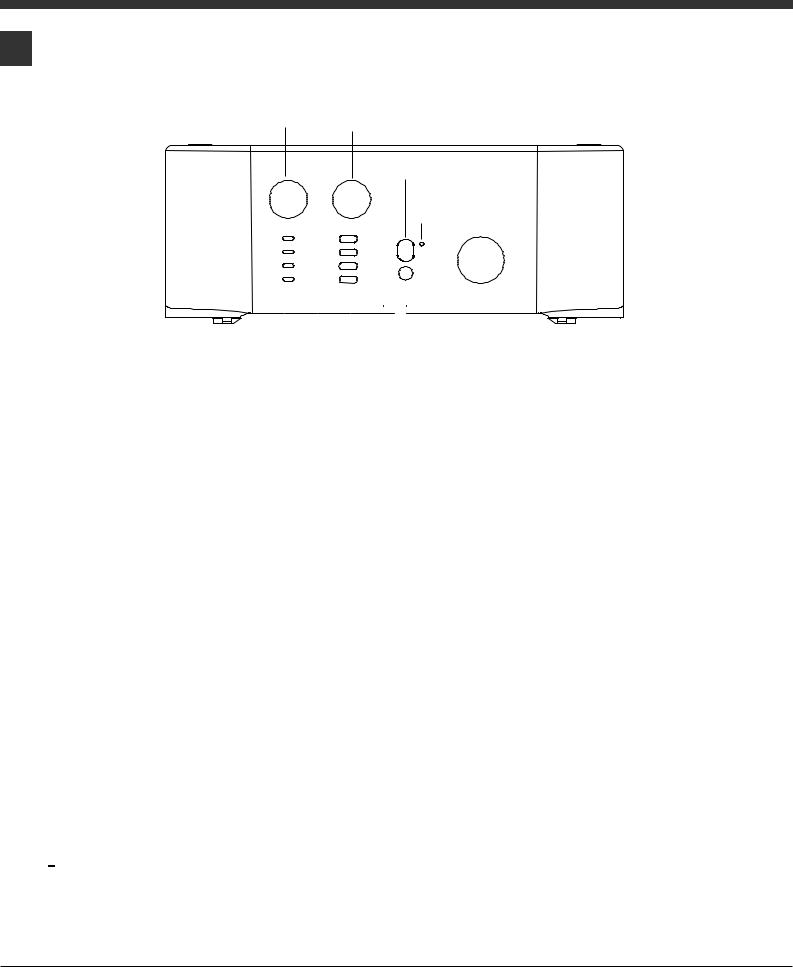
Description du lave-linge
F Bandeau de commandes
Bouton |
Bouton |
ESSORAGE |
TEMPÉRATURE |
Touche MISE EN
MARCHE/ARRET
Voyant COUVERCLE
VERROUILLÉ
|
|
|
|
|
|
|
|
|
|
|
|
|
|
|
|
|
|
|
|
|
|
|
|
|
|
|
|
|
|
Voyants |
|
Touche |
|
|
|
|
|
||
|
|
|
|||||||
|
|
|
START/RESET |
|
|
||||
|
Touches |
|
|
|
|
|
Bouton |
||
|
FONCTION |
PROGRAMMES |
|||||||
Tiroir à produits lessiviels pour charger produits lessiviels et additifs (voir page 20).
Voyants pour suivre le stade d'avancement du programme de lavage.
Si la fonction Delay Timer (départ différé) a été sélectionnée, ils indiquent le temps restant avant le démarrage du programme (voir page 17).
Bouton ESSORAGE: réglage de la vitesse d'essorage ou exclusion (voir page 19).
Bouton TEMPÉRATURE: modification de la température de lavage de 90° a O° (voir page 19).
Touches FONCTION pour sélectionner les fonctions disponibles. La touche correspondant à la fonction sélectionnée restera allumée.
Touche MISE EN MARCHE/ARRET: mise en marche ou arrêt du lave-linge. (voir page 18).
Touche START/RESET: démarrage des programmes ou annulation (en cas d'erreur).
Voyant MARCHE/COUVERCLE VERROUILLE pour comprendre si le lave-linge est allumé (clignotant) et si le couvercle peut être ouvert (fixe) (voir page 17).
Bouton PROGRAMMES pour sélectionner les programmes (voir page 18).
Pendant le programme, le bouton ne bouge pas.
 Voyant MARCHE/COUVERCLE VERROUILLE:
Voyant MARCHE/COUVERCLE VERROUILLE:
Le symbole éclairé indique que le couvercle est verrouillé pour éviter toute ouverture accidentelle; attendez que le voyant clignote avant de l'ouvrir.
Le clignotement rapide du voyant MARCHE/COUVERCLE VERROUILLE en même temps qu'un autre signale une anomalie. Appelez le service d'Assistance Technique.
16

Comment ouvrir et fermer le tambour
Fig. 1 |
Fig. 2 |
|||||
|
|
|
|
|
|
|
|
|
|
|
|
|
|
|
|
|
|
|
|
|
|
|
|
|
|
|
|
Fig. 3 |
Fig. 4 |
Voyants
Les voyants fournissent des informations importantes. Voilà ce qu'ils signalent:
Phases en cours:
Pendant le cycle de lavage, les voyants s'allument progressivement pour indiquer son stade d'avancement:
Prélavage
Lavage
Rinçage
Essorage
Remarque: pendant la phase de vidange, le voyant correspondant à la phase Essorage s'allume.
.
A)Ouvrez le couvercle. (Fig. 1). Soulevez le Couvercle externe et ouvrez le complètement;
B)Ouvrez ensuite les Portes du tambour à l’aide de vos deux mains comme indiqué sur la Fig. 2):
•appuyez sur la touche indiquée par la flèche sur la Fig. 2) et tout en appuyant légèrement vers le bas posez une main pour éviter que les portes ne vous fassent mal aux adoigts en s’ouvrant soudainement;
•accompagnez dans leur mouvements les portes qui se décrocheront et s’ouvriront facilement.
C)INTRODUISEZ LE LINGE. (Fig. 3).
D)FERMEZ. (Fig. 4).
•refermez bien le tambour en baissant d’abord la porte antérieure et posez ensuite la porte postérieure;
•faites attention à parfaitement positionner les crochets de la porte antérieure dans leur siège dans la porte postérieure;
•vous entendrez un “ clac ” qui confirmera la bonne fixation;
appuyez alors légèrement vers le bas sur les deux portes qui ne doivent pas se décrocher;
•fermez enfin le couvercle externe.
Touches fonction
La sélection d'une fonction entraîne l'allumage du voyant correspondant.
Si la fonction sélectionnée est incompatible avec le programme sélectionné, la touche clignote et la fonction n'est pas activée.
En cas de sélection d'une fonction incompatible avec une autre précédemment sélectionnée, la seule à être activée sera la dernière validée.
F
Installation
Description
Programmes
produits Bac
Précautions
Entretien
Anomalies
Assistance
17

Mise en marche et Programmes
En bref: démarrage d'un pro- F gramme
1. Pour allumer le lave-linge appuyez sur la touche  . Tous les voyants s'allument pendant quelques secondes puis s'éteignent et le voyant ALLUMAGE/ COUVERCLE VERROUILLE commence à clignoter.
. Tous les voyants s'allument pendant quelques secondes puis s'éteignent et le voyant ALLUMAGE/ COUVERCLE VERROUILLE commence à clignoter.
2. Chargez le lave-linge, versez le produit lessiviel et les additifs (voir page 20) et fermez les portes et le couvercle.
3.Sélectionnez à l'aide du bouton PROGRAMMES le programme désiré.
4.Sélectionnez la température de lavage (voir page 19).
5.Sélectionnez la vitesse d'essorage (voir page 19).
6.Appuyez sur la touche START/RESET pour lancer
le programme.
Pour annuler, poussez sur la touche START/RESET pendant 2 secondes au moins.
7.A la fin du programme de lavage, le voyant ALLUMAGE/ COUVERCLE VERROUILLE clignote pour indiquer que le couvercle peut être ouvert. Sortez le linge et laissez
le couvercle entrouvert pour faire sécher le tambour. Eteignez le lave-linge en appuyant sur la touche  .
.
Tableau des programmes
Nature des tissus et degré |
|
Program- |
Temp. |
Lessive |
Assouplis- |
Option Anti- |
Durée |
|
||
|
|
|
tâches/ Eau |
du cycle |
Description du cycle de lavage |
|||||
de salissure |
|
mes |
lavage |
|
|
sant |
||||
|
prélav. |
lavage. |
de Javel |
(minutes) |
|
|||||
|
|
|
|
|
|
|
||||
|
|
|
|
|
|
|
|
|
||
|
|
|
|
|
|
|
|
|
|
|
Coton |
|
|
|
|
|
|
|
|
|
|
Blancs extrêmement sales |
|
1 |
90° C |
• |
• |
• |
|
137 |
Prélavage, lavage, rinçages, |
|
(draps, nappes, etc.) |
|
|
essorages intermédiaires et finaux |
|||||||
|
|
|
|
|
|
|
|
|
||
|
|
|
|
|
|
|
|
|
|
|
Blancs extrêmement sales |
|
2 |
90° C |
|
• |
• |
Délicate/ |
129 |
Lavage, rinçages, essorages |
|
(draps, nappes, etc.) |
|
|
Traditionnelle |
intermédiaires et finaux |
||||||
|
|
|
|
|
|
|
|
|||
|
|
|
|
|
|
|
|
|
|
|
Blancs et couleurs |
|
3 |
60° C |
|
• |
• |
Délicate/ |
144 |
Lavage, rinçages, essorages |
|
résistantes très sales |
|
|
Traditionnelle |
intermédiaires et finaux |
||||||
|
|
|
|
|
|
|
|
|||
|
|
|
|
|
|
|
|
|
|
|
Blancs peu sales et couleurs |
|
4 |
40° C |
|
• |
• |
Délicate/ |
78 |
Lavage, rinçages, essorages |
|
délicates (chemises, pulls, etc.) |
|
|
Traditionnelle |
intermédiaires et finaux |
||||||
|
|
|
|
|
|
|
|
|||
|
|
|
|
|
|
|
|
|
|
|
Couleurs délicates peu sales |
|
5 |
30° C |
|
• |
• |
Délicate/ |
70 |
Lavage, rinçages, essorages |
|
|
|
Traditionnelle |
intermédiaires et finaux |
|||||||
|
|
|
|
|
|
|
|
|
||
|
|
|
|
|
|
|
|
|
|
|
Synthétiques |
|
|
|
|
|
|
|
|
|
|
Couleurs résistantes très |
|
6 |
60° C |
|
• |
• |
Délicate |
79 |
Lavage, rinçages, anti- |
|
sales (linge de bébé, etc.) |
|
|
froissement ou essorage délicat |
|||||||
|
|
|
|
|
|
|
|
|
||
Couleurs résistantes très |
|
7 |
50° C |
|
• |
• |
Délicate |
75 |
Lavage, rinçages, anti- |
|
sales (linge de bébé, etc.) |
|
|
froissement ou essorage délicat |
|||||||
|
|
|
|
|
|
|
|
|
||
|
|
|
|
|
|
|
|
|
|
|
Couleurs délicates (linge en |
|
8 |
40° C |
|
• |
• |
Délicate |
65 |
Lavage, rinçages, anti- |
|
tout genre légèrement sale) |
|
|
froissement ou essorage délicat |
|||||||
|
|
|
|
|
|
|
|
|
||
Couleurs délicates (linge en |
|
9 |
30° C |
|
• |
• |
|
32 |
Lavage, rinçages et essorage |
|
tout genre légèrement sale) |
|
|
|
délicat |
||||||
|
|
|
|
|
|
|
|
|
||
|
|
|
|
|
|
|
|
|
|
|
Délicats |
|
|
|
|
|
|
|
|
|
|
Laine |
|
10 |
40° C |
|
• |
• |
Délicate |
45 |
Lavage, rinçages et essorage |
|
|
|
délicat |
||||||||
|
|
|
|
|
|
|
|
|
|
|
|
|
|
|
|
|
|
|
|
|
|
Tissus particulièrement délicats |
|
11 |
30° C |
|
• |
• |
|
52 |
Lavage, rinçages, anti- |
|
(rideaux, soie, viscose, etc.) |
|
|
|
froissement ou vidange |
||||||
|
|
|
|
|
|
|
|
|
||
|
|
|
|
|
|
|
|
|
|
|
PROGRAMMES PARTIAUX |
|
|
|
|
|
|
|
|
|
|
Rinçage |
|
|
|
|
|
|
• |
|
|
Rinçages et essorage |
|
|
|
|
|
|
|
|
|
|
|
Rinçage délicat |
|
|
|
|
|
|
• |
|
|
Rinçages, anti-froissement ou |
|
|
|
|
|
|
|
|
vidange |
||
|
|
|
|
|
|
|
|
|
|
|
Essorage |
|
|
|
|
|
|
|
|
|
Vidange et essorage énergique |
|
|
|
|
|
|
|
|
|
|
|
Essorage délicat |
|
|
|
|
|
|
|
|
|
Vidange et essorage délicat |
|
|
|
|
|
|
|
|
|
|
|
Vidange |
|
|
|
|
|
|
|
|
|
Vidange |
|
|
|
|
|
|
|
|
|
||
|
|
|
|
|
|
|
|
|
||
|
|
|
|
|
|
|
|
|
|
|
Remarque
Pour la fonction anti-froissement: voir Repassage facile, page ci-contre. Les données reportées dans le tableau sont à titre indicatif.
Programme spécial
Quotidien 30' (programme 9 pour Synthétiques) spécialement conçu pour laver du linge peu sale en un rien de temps: il ne dure que 30 minutes et permet ainsi de faire des économies d'énergie et de temps. Choisissez le programme (9 à 30°C), vous pourrez laver ensemble des textiles différents (sauf laine et soie) en ne dépassant pas 3 kg de charge. Nous vous conseillons d'utiliser des lessives liquides.
18
